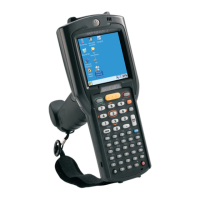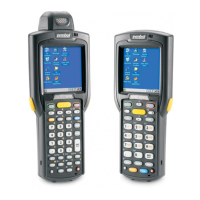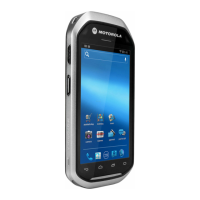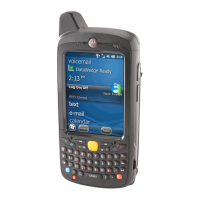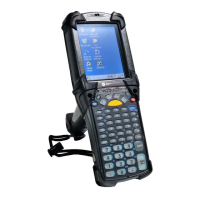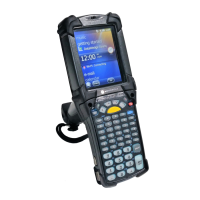• Windows CE: The complete Windows CE operating system is stored on Flash devices. If necessary, the entire OS
image may be downloaded to the MC32N0 using files provided by Zebra. Any upgrades must be obtained from
Zebra. This partition is mandatory for the MC32N0.
• Splash Screen: a bitmap smaller than 16 Kb (and limited to 16 bits per pixel) is displayed as the MC32N0 cold
boots. To download a customized screen to display, see Creating a Splash Screen on page 157.
• Bootloader: This program interfaces with the host computer and allows downloading via USB cable any or all of
the partitions listed above, as well as updated versions of Bootloader. Use caution downloading updated
Bootloader versions; incorrect downloading of a Bootloader causes permanent damage to the MC32N0.
Bootloader is mandatory for the MC32N0.
• Partition Table: Identifies where each partition is loaded in the MC32N0.
Downloading Partitions to the MC32N0
USBDownload is used to specify a hex destination file for each partition and download each file to the MC32N0.
This download requires a program loader stored on the MC32N0. The MC32N0 comes with a program loading utility,
Bootloader, stored in the MC32N0's write-protected flash.
Bootloader
Bootloader allows the user to upgrade the MC32N0 with software updates and/or feature enhancements.
Partition Update vs. File Update
There are two types of updates supported by the MC32N0: partitions and files. The file system used by the MC32N0
is the same as the file system used on a desktop computer. A file is a unit of data that can be accessed using a file
name and a location in the file system. When a file is replaced, only the contents of the previous file are erased. The
operating system must be running for a file to be updated, so the Bootloader cannot perform individual file updates as
it is a stand-alone program that does not require the operating system to be running.
A typical partition is a group of files, combined into a single “partition” that represents a specific area of storage.
Examples of partitions are the flash file systems such as Platform or Application. (Using the desktop computer
comparison, these partitions are roughly equivalent to a C: or D: hard disk drive.) In addition to the “hard disk”
partitions, some partitions are used for single items such as the operating system, monitor, or splash screen. (Again
using a desktop computer comparison, these partitions are roughly the equivalent of the BIOS or special hidden
system files.) When a partition is updated, all data that was previously in its storage region is erased - i.e. it is not a
merge but rather a replacement operation. Typically, the operating system is not running when partitions are update,
so Bootloader can perform partition updates.
All partition images suitable for use by Bootloader are in hex file format for transfer by USBDownloader from the
development computer to the MC32N0.
Upgrade Requirements
Upgrade requirements:
• The hex files to be downloaded (on development computer)
• A connection from the host computer and the MC32N0
• USBDownload (on development computer) to download the files.
Once these requirements are satisfied, the MC32N0 can be upgraded by invoking Bootloader and navigating the
menus. See Bootloader on page 5-5 for procedures on downloading a hex file to the MC32N0.
Deployment
This section provides information about installing software and files on the MC22N0.
Software deployment can be performed by:
148 | Application Deployment for Windows CE
April 2015 | MN000887A01-B
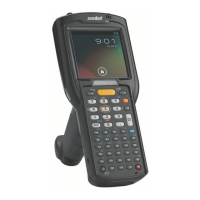
